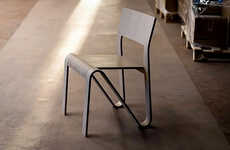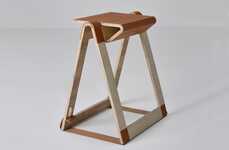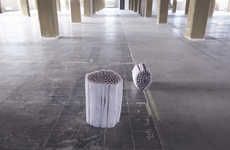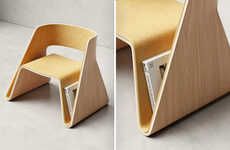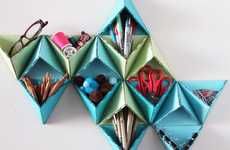
The Mount Lebanon Chair Celebrates and Elevates Craftsmanship
Amelia Roblin — March 20, 2013 — Art & Design
References: paulloebach
Even looking closely at the Mount Lebanon Chair, can you tell that the entire thing has been carefully constructed from Bristol paper and foam core? Indeed, the familiar household furnishing is not made of conventional wooden material, rather functioning as a study and a model of a nostalgic design idea.
Paul Loebach was inspired by the products that were meticulously crafted by the Shakers in 19th-century America. This traditional dining chair is complete with tapering legs, carved backrest posts and a seat that's woven between the four sides of the frame. The apparently rounded quality of the components -- when viewed from a comfortable distance -- is achieved with a fine multifaceted assembly. Executed at a scale of 1:1, the Mount Lebanon Chair is displayed on a set of coat hooks and must not be used to bear weight.
Paul Loebach was inspired by the products that were meticulously crafted by the Shakers in 19th-century America. This traditional dining chair is complete with tapering legs, carved backrest posts and a seat that's woven between the four sides of the frame. The apparently rounded quality of the components -- when viewed from a comfortable distance -- is achieved with a fine multifaceted assembly. Executed at a scale of 1:1, the Mount Lebanon Chair is displayed on a set of coat hooks and must not be used to bear weight.
Trend Themes
1. Origami Furniture - As the popularity of origami style furniture rises, crafting these pieces using unconventional materials could lead to a new era of sustainable design.
2. Nostalgic Designs - Designers who look to the past for inspiration, like Loebach did with the traditional Shaker chair, can create new twists on classic pieces that appeal to modern consumers.
3. Paper-based Furniture - The use of paper-based materials in furniture-making could lead to breakthroughs in lightweight, eco-friendly furniture that can be easily assembled and transported.
Industry Implications
1. Furniture Design - Exploring unconventional materials and traditional design techniques can give furniture designers a new edge in a crowded marketplace.
2. Sustainability - Incorporating eco-friendly materials into furniture production has the potential to shape the future of sustainable design practices.
3. Craftsmanship - Honoring the art of traditional craftsmanship and exploring how it can be translated into modern design is a trend that could resonate with discerning consumers.
2.1
Score
Popularity
Activity
Freshness



